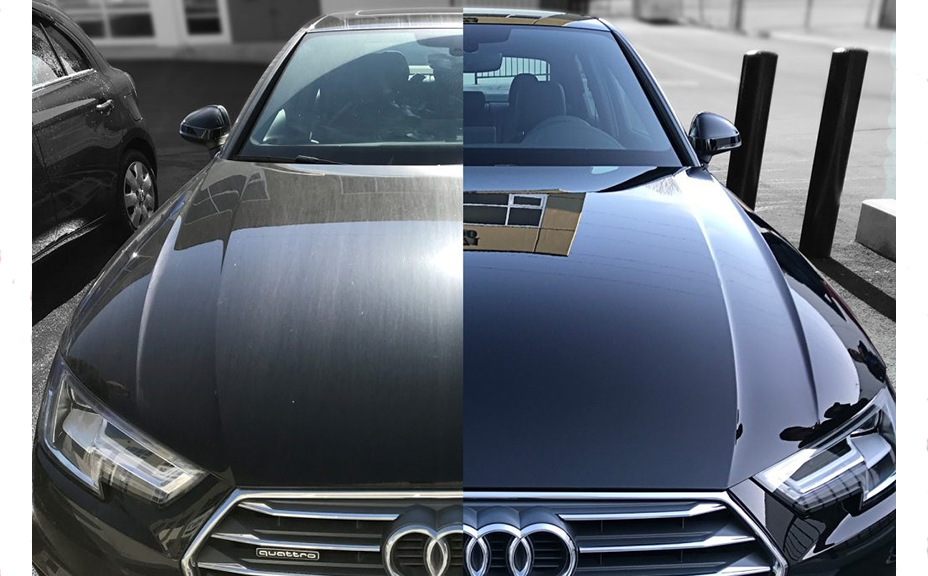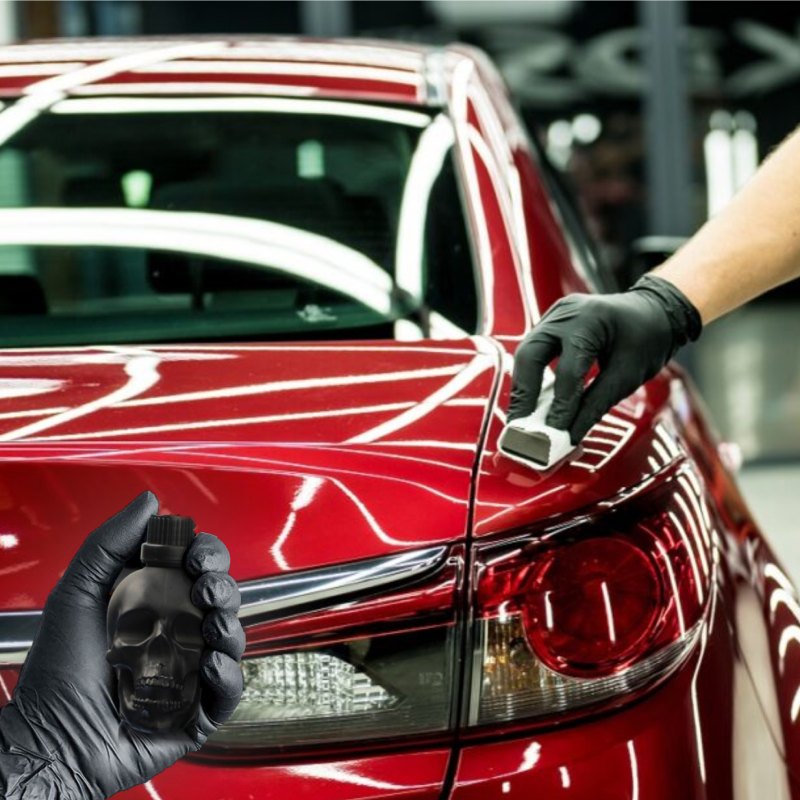Eight common questions about Ceramic Coating Newark answered
Wiki Article
Checking out the Scientific Research Behind Car Ceramic Coating and Its Protective Qualities
The scientific research of car ceramic coating presents a fascinating research in innovative automotive protection. Made up largely of silicon dioxide and polymers, these layers create a robust bond with automobile paint. This communication boosts durability against environmental risks while using hydrophobic benefits. The details of just how these layers job and their long-term benefits continue to be much less recognized. Ceramic Coating Newark. Unboxing these details reveals why ceramic layers are ending up being a preferred choice for automobile treatmentWhat Is Ceramic Coating?
Ceramic coating is a fluid polymer that chemically bonds to the surface of an automobile's paint. This sophisticated protective layer enhances longevity and supplies exceptional resistance to environmental variables. Unlike conventional wax or sealants, which provide temporary security, ceramic finishes produce a durable guard that can endure harsh conditions such as UV rays, acidic impurities, and severe climate. When applied properly, the coating develops a hydrophobic surface area, creating water to grain and slide off, which helps in keeping the automobile's tidiness. In addition, it uses enhanced gloss and deepness to the paint, making the car appear even more polished and dynamic. The application process normally involves extensive surface area prep work, consisting of cleansing and sprucing up, to guarantee peak bonding. Therefore, ceramic layers are ending up being progressively prominent amongst car enthusiasts and those looking for to secure their investments, guaranteeing to keep the car's visual appeal while reducing the frequency of upkeep.The Composition of Ceramic Coatings
The complex formulation of ceramic finishings mostly includes silicon dioxide (SiO2), which is stemmed from natural sources like quartz and sand. This key element offers the structure for the coating's resilience and safety top qualities. In addition to SiO2, ceramic finishings usually consist of numerous polymers and additives that enhance adhesion, flexibility, and resistance to environmental aspects. These compounds function synergistically to produce a durable obstacle against pollutants such as dirt, chemicals, and UV rays.Furthermore, some formulations integrate titanium dioxide (TiO2) or other nanomaterials, which can enhance the coating's hydrophobic residential properties, resulting in improved water repellency. The precise structure can vary significantly among makers, influencing efficiency and longevity. Eventually, the combination of these components finishes in a protective layer that not only enhances the visual charm of lorries yet additionally offers to lengthen their life-span by shielding the surface from possible damages.Exactly How Ceramic Coatings Job
Understanding how ceramic coatings function involves exploring their chemical make-up, which adds to their safety top qualities. The application process is essential for accomplishing perfect outcomes, while longevity and toughness elements determine the coating's effectiveness in time. With each other, these aspects highlight the benefits and efficiency of ceramic layers for lorry security.Chemical Composition Explained
While lots of car proprietors look for lasting defense for their automobiles, the chemical make-up of ceramic coverings plays a vital role in their effectiveness. These finishes largely include silicon dioxide (SiO2), which is originated from natural minerals. This compound forms a strong bond with the automobile's paint, creating a long lasting, protective layer. Furthermore, numerous ceramic layers contain titanium dioxide (TiO2), boosting their hydrophobic residential or commercial properties and resistance to UV rays. The existence of polysiloxanes can better enhance versatility and sturdiness. With each other, these elements add to the coating's ability to repel water, dirt, and pollutants, while also offering a high-gloss finish. Recognizing this chemical foundation helps car proprietors appreciate the durable protection supplied by ceramic coatings.Application Refine Summary
Applying ceramic finishings entails a careful process that assures ideal bonding and protection for the vehicle's surface. Extensive cleansing and purification of the car's outside are performed to get rid of dust, crud, and previous waxes. This step verifies that the surface area is devoid of pollutants that might impede adhesion. Following this, the paint is frequently polished to boost clearness and remove any imperfections. As soon as prepared, the ceramic coating is applied in small sections using an applicator pad, enabling uniform protection. The coating is then entrusted to heal, developing a solid chemical bond with the surface. Appropriate curing times and problems are essential, as they confirm the coating attains its maximum performance and protective qualities.Durability and Sturdiness Variables
Ceramic finishes are designed to supply lasting defense with their innovative chemical structure, which creates a durable barrier versus ecological contaminants. The durability of these layers is affected by variables such as the density of the application, the high quality of the item, and the conditions under which the car is exposed. High-grade ceramic finishings can last a number of years, resisting scrapes, UV rays, and chemical stains. Proper maintenance, consisting of routine cleaning and periodic reapplication, can additionally enhance longevity. Furthermore, environmental factors like environment and exposure to contaminants can impact the life-span of the coating. Generally, when applied and maintained properly, ceramic finishings use phenomenal sturdiness, making them a popular option for car fanatics seeking to maintain their car's appearance.Hydrophobic Qualities and Water Repellency
Hydrophobic buildings are a trademark of top quality car ceramic coverings, substantially enhancing the car's surface area efficiency. These finishes produce a molecular bond with the a knockout post car's paint, resulting in a surface area that pushes back water effectively. When water enters into call with a ceramic-coated Full Report surface area, it beads up and rolls off, decreasing the amount of liquid that stays on the paint. This behavior not just contributes to a visually pleasing look yet additionally reduces the build-up of impurities such as dust, grime, and road salts.The boosted water repellency leads to simpler cleaning and maintenance, as less effort is needed to remove unwanted materials. On top of that, the hydrophobic nature of ceramic finishings helps in stopping water places, which can mar the finish of uncoated surfaces. In general, the consolidation of hydrophobic properties in ceramic coatings plays a vital duty in keeping the lorry's excellent look while streamlining upkeep.Defense Versus Scratches and UV Damage
Car ceramic layers offer substantial defense against scratches and UV damages. The scratch resistance system develops a resilient layer that soaks up effects, while the UV shielding advantages aid preserve the car's paint integrity over time. With each other, these functions add to a longer-lasting and visually appealing surface.Damage Resistance Mechanism
Using advanced technology, ceramic finishes provide a durable guard versus scratches and UV damages, improving the longevity and look of lorry surface areas. The scrape resistance system of these finishes is credited to their special molecular framework, which creates a sturdy bond with the automobile's paint. This bond creates a hard, safety layer that can absorb effects and resist abrasions. Additionally, the smooth surface of the coating lowers friction, making it hard for impurities to stick and create scrapes. The chemical composition of ceramic finishings usually includes nanoparticles that reinforce the safety layer, further enhancing its strength. Lorries treated with ceramic coatings show substantially improved scratch resistance contrasted to typical wax or sealers, making sure an excellent finish over time.UV Shielding Benefits
The protective qualities of ceramic layers extend past scrape resistance to consist of considerable UV securing benefits. These finishes create a robust barrier that reflects unsafe ultraviolet rays, securing the vehicle's paint and underlying materials. Prolonged direct exposure to UV radiation can bring about fading, oxidation, and wear and tear of the paint surface. By incorporating ceramic coatings, lorry proprietors can successfully mitigate these risks, preserving the visual charm and integrity of their cars. In addition, the UV obstructing properties contribute to improved durability, reducing the regularity of painting and site maintenance. Eventually, the integration of ceramic coverings supplies a detailed option for safeguarding cars from the destructive impacts of sunlight direct exposure, ensuring a sustained, vivid look over time.The Durability and Upkeep of Ceramic Coatings

Frequently Asked Concerns
Can Ceramic Coating Be Applied to Any Type Of Sort Of Lorry?
Ceramic coating can be related to various kinds of cars, consisting of autos, trucks, and motorcycles. Surface prep work and compatibility with specific products are necessary for optimal attachment and efficiency of the coating.Just How Much Does Ceramic Coating Generally Price?
Ceramic coating normally sets you back in between $500 and $2,000, depending upon aspects such as vehicle dimension, coating top quality, and specialist application. The financial investment can supply resilient defense and boost the automobile's look over time.
Is Specialist Application Required for Best Outcomes?
The requirement of professional application typically depends on wanted results. Experts typically assure proper surface area preparation and application strategies, causing optimal bonding and long life of the coating, which may be testing for inexperienced people to accomplish.Can Ceramic Coatings Be Eliminated or Fixed?
Ceramic finishes can be gotten rid of or repaired, though the process might need certain solvents or techniques - Ceramic Coating Newark. Correct removal is important to stay clear of damages to the underlying surface area, highlighting the importance of specialist assistance for ideal outcomesJust How Does Ceramic Coating Compare to Typical Wax?
The contrast in between ceramic coating and conventional wax exposes that ceramic layers offer premium resilience, boosted protection against ecological contaminants, and longer-lasting luster, while wax calls for more frequent application and supplies much less overall resistance to damage.Report this wiki page